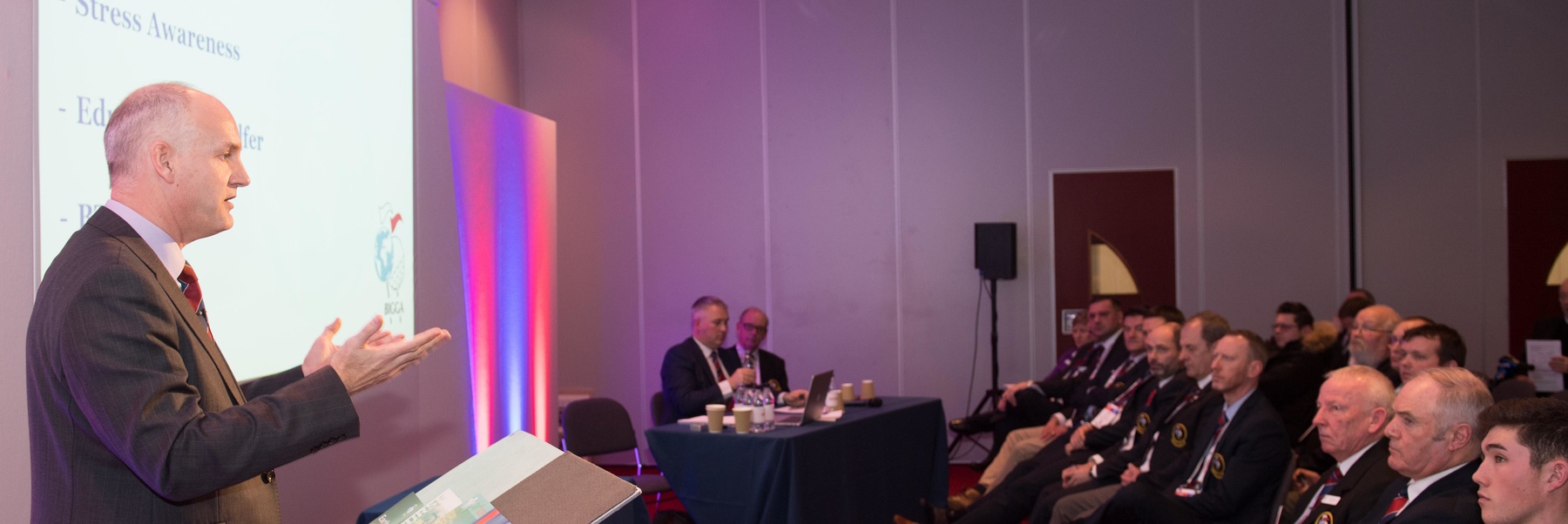
As the BIGGA Turf Management Exhibition approaches, Jim Croxton, CEO of the British & International Golf Greenkeepers Association, sat down with GBN contributor Ross Biddiscombe to discuss not only the new look for the January event but also the urgent need for a change in the way that some golf clubs manage their course-management staff
Your annual exhibition BTME, is on the horizon. What can we look forward to there?
We’re really looking forward to this year’s exhibition because there’s so much going on. Each year we welcome around 5,000 visitors to the Harrogate Convention Centre and it’s no exaggeration to say that for that week in January, BTME becomes the centre of European turf management. For everyone involved, it’s an adrenalin-filled week and this year we’ve shaken things up a little bit, which makes things even more exciting.
There are interesting things happening in education. We’re recognising that there are definite stages in the greenkeeper’s career – each with their own specific requirements – so this year the Young Greenkeepers Conference is very much aimed at people in the first two or three years in the job. We’ve introduced a Deputies Conference, because we recognise that it’s a big leap to go into supervision, particularly when you move up within the same team.
We have special interest topics like ecology and links management conferences and the response to those has been good. The tree management course filled up after three weeks and we were 15% ahead in terms of bookings by the beginning of November compared to the same time last year.
Also, BTME 2019 will look and feel different as we’re using the venue differently to provide a better and more engaging experience for the visitor. We’ve used pretty much the same space for 30 years and it was time to freshen things up a little bit.

Our average visitor stay is 1.5 days, which is massive in trade show terms, due to the education programme and the networking opportunities in the evenings. We want visitors to stay even longer and have more to do. I think we will be sold out of exhibition space before Christmas and that presents a new challenge – we may have to get an even bigger space next year.
Visitors network from breakfast to the last drink of the night and that’s unique in the turf industry. Other similar exhibitions don’t have that. We’re very protective of the venue and timing because it’s the perfect time of year for the industry to gather. The show is getting better and growing because the exhibitors, the greenkeepers, the visitors and ourselves, the organisers, are committed to it because it’s an important part of our annual rhythm.
Should more greens committee chairman come along?
They’re most welcome and we do get a lot of golf club officials, predominantly from the north of England and the Midlands. Actually, 500 of the 5,000 visitors last year were from outside of the UK. They think it’s the most important show in Europe.
When a greenkeeper or superintendent and his greens committee chair walk around the show together, it’s easier to make the big decisions for the club, better than having one of them attend and bring back lots of information and then having to have it all explained.
My chairman and I spend a lot of time outside of the turf industry, speaking to governing bodies and golf clubs at conferences and seminars, thousands of people every year. It’s a drip-feed message and we’re making a difference, but there are 2,500+ clubs out there in the UK. Many of them are doing great and are happy with the greenkeeping staff and there are some great greens chairman who walk around our show and are on the same page as our members. They progress together in a perfect direction. Being together at our show is very valuable because they find out how they’re working in comparison to other clubs.
A huge issue at the moment is the welfare of your members and the relationship that they have with golf club committee members and golf clubs in general. The pressure on greenkeepers and superintendents seems more intense than ever.

The single biggest issue in the sport is the governance of the facilities where it is played. In practically every other sport, there is a top-down governance. The FA, the RFU, the ECB run the sport and their clubs fit in so they have the privilege of playing and delivering in that sport. Golf is run from the bottom-up: clubs do what they like and, arguably, the governing bodies fit in where they can.
I go to the Golf Forum meeting twice a year with all the various governing bodies in our sport and this governance discussion is always on the table. We can sit and come up with some initiatives to grow the game, but if the golf clubs say they’re not interested, then nothing happens on the ground. The problem is that the majority of golf clubs in this country are still run by the members and their committees and it’s become very difficult to get to the majority of members. The number of people involved in the governance and the suitability of their governance is different to what it was 30 years ago.
Is the situation better or worse than it was back then?
It’s different, but from our prospective, it’s worse because often the golf club members with the loudest voices and the strongest opinions are finding their way on to the committees. It’s a bit of a cliché, but the person taking up their first role at a club often starts on the greens committee because that’s the job no one wants. That person wants to make their mark, but they are dealing with a professional person (that’s our greenkeeper) who is passionate about their role and needs support. I don’t deny greenkeepers also need challenging to an extent, but the club member is often coming at things challenge-first.
We want to emphasise that greens committees should always speak to the greenkeeper constructively to address any issues. Yes, the clubs may have concerns about their greenkeepers, but usually our members just need support. Our organisation can give them more training and greenkeepers are very adaptable, so if a new golf club regime wants something done differently, then they have to make their point clear and we can all move ahead from there. But, typically, one regime appoints our member and then another group comes along and wants change but doesn’t always know how to achieve it.
Have there been some extreme cases?
We had one case of a club member launching a petition aimed at getting rid of the greenkeeper. The petition didn’t get much traction, but, two years later, that member was appointed chairman of the greens committee. That’s about the most ludicrous thing I’ve ever heard and that’s a club who had a really good greenkeeper. Surprise, surprise, that greenkeeper had to leave his job due to stress and now we’re nursing him back. He’s in a better place now, but what kind of business allows a case like that to happen?
The whole golf industry has a problem, because that kind of golf club member is often determining not just how a greenkeeper is treated, but other issues like whether to allow juniors to play or if the club needs flexible membership and all the things that will allow the golf club to thrive. Some people are ill-equipped to make those decisions.
Your new magazine – ‘Your Course’– is two issues old and reaching out to golf club members, so will that help the situation?
 We plan to publish Your Course twice a year and it has gone down well in golf clubs. Your Course gives our BIGGA members support and it shows that what they’re saying to committee members at clubs is the truth, because they are being backed up by a large national body. The magazine will come out at the two pinch points in the year for greenkeepers, the spring and the autumn – that’s the start and the end of the season, when we have most of our challenges. Most golfers are happy in the summer when the course is playing nicely.
We plan to publish Your Course twice a year and it has gone down well in golf clubs. Your Course gives our BIGGA members support and it shows that what they’re saying to committee members at clubs is the truth, because they are being backed up by a large national body. The magazine will come out at the two pinch points in the year for greenkeepers, the spring and the autumn – that’s the start and the end of the season, when we have most of our challenges. Most golfers are happy in the summer when the course is playing nicely.
How much will it help? Well, the pessimistic answer to many of our issues is that they are societal and so there is little we can do. There are people who hark back to the golden years, but today’s greenkeepers will have more criticism on social media, more members’ meetings to attend, and be more aware of complaints from the clubhouse. The golfer speaking in the clubhouse and on social media is like the BBC radio programme 606 – they have a viewpoint, they want to be heard, and they have a soapbox to stand on.
What are your greenkeepers and course managers doing to help themselves?
We have our own social media channels, reserved for BIGGA members, where they can ask their peers for advice and comment, but it’s also where they can vent about things.
Greenkeepers can’t really vent their frustrations about things in their own clubhouse as they don’t have an audience that understands what they are going through.
We have some pretty shocking examples of what’s been said about greenkeepers on social media. But, actually, all that we ask golf club members to do is obey the law. Most of the bad behaviour – and it’s not an epidemic, although I could point to a few dozen cases of difficult situations for our members – is either illegal in employment law terms or it’s bullying.
The golf club has a duty of care to all members of staff, but the worry is that some clubs don’t want to upset the club member because it’s easier to appoint staff than it is to recruit a new member. And that’s a pretty tough position for a golf club business to find itself in.
Is education of BIGGA members the solution because, surely, they’re doing the best job they can under a lot of pressure?

We have a three-pronged approach to issues that stress out our greenkeepers. Firstly, we have to educate the industry so these incidents are reduced and, secondly, we’ve also got to educate our members to handle it better – one of the best ways to do this is by being proactive with communicating to members. Thirdly, we have to help our members who are already in a difficult situation.
Work-related stress has caused long-term illness and, in some cases, even suicide, and that is just unthinkable. Our regional team of Membership Services Managers spend much of their time helping members with difficulties. It’s time and money wasted trying to reverse this problem, rather than money spent progressing. We gladly spend that money to help out our members in difficulty, but wouldn’t it be wonderful if we could spend it on other things like education, improving turf conditions and helping golf clubs?
Is there one single thing that golf clubs should do to help the situation?
Treat your greenkeeper as a trained, professional member of staff. It’s pretty simple. In the cases where there is a golf club with a proper management system, with the structure in place to cope when greens committee chairmen change, then that’s fine.
But there are potentially hundreds of clubs that are broken in terms of governance and it is a real problem. Just because you play to a single figure handicap doesn’t mean that you know about greens maintenance. I’m a governor of my kid’s school and I know nothing about teaching. I have no authority or right to talk about teaching standards of the school. I can talk about my experience as a parent and that of my child and those of the other people in the community. But if the school governors want to find out about teaching standards, then we call in an expert.
In the same way, if you have concerns as a golf club about greenkeeping, then you bring in BIGGA to help and we’re delighted to do that. If you want an independent voice, then we can recommend someone else, but there’s not much willingness from clubs to ask these questions.
Over the last 12 months, pre-tribunal job dispute settlements to greenkeepers have amounted to pay-outs of hundreds of thousands of pounds. That amounts to dozens of cases where golf clubs have got it wrong and it means money going out of the sport that could’ve been better served to train members of staff and improve their resources. The same is true for other members of staff at golf clubs, but the most emotive aspect of any club is the state of the golf course. I like it if the kitchen provides a nice bacon sandwich, but I’m more concerned about if my golf ball runs true towards the hole.
What about women in your industry; are the numbers increasing?
Yes, they are increasing, but from a very low base. Right now, the Berkshire College of Agriculture has four women students out of a class of about 30 and that alone is a big step. Wales has its first female head greenkeeper at Wenvoe Castle, Lucy Sellick, so it’s starting to happen.
America is ahead of us in this issue because senior level greenkeeping is a university-first and vocation-second procedure over there. Here it’s more organic. At BTME this year we’ll host a specific get-together for women greenkeepers because women amount to such a small percentage of the attendees and the experience can be intimidating.

Golf club management is ahead of greenkeeping in this area perhaps because it’s more of an office role. But greenkeeping appears to be less about size and strength these days and women greenkeepers don’t feel there’s any task out on the course that they can’t do.
It’s more of a cultural barrier at the moment. The average greenkeeping crew is between five and six people, all male, with one toilet. Hiring a woman means changing the facilities and that’s a challenge in a low budget facility. In the larger teams, we get more female greenkeepers.
And what about course managers who are moving into golf club management?
My view is that a good course manager now has all the skills to be a good general manager – finance, strategic thinking, people management and long-term planning. There are some very good general managers that are ex-greenkeepers.
For a long time, the golf course has been thought to be separate from the clubhouse, but more and more golf clubs recognise that they are a single business. Someone from the golf industry with suitable training can do the general manager job really well and that is becoming widely recognised. I think it’s a good thing. There are greenkeepers everywhere who have good people skills and commercial skills and they’re being snapped up.
For example, the commercial representatives in our industry used to have a sales background, but now it’s increasingly common to find that they were once a greenkeeper or course manager. They have learned to sell, but their background gives them authority and they are able to find a product that is most suitable for the course and their budget.
Jim Croxton, thank you very much
BIGGA www.bigga.org.uk

